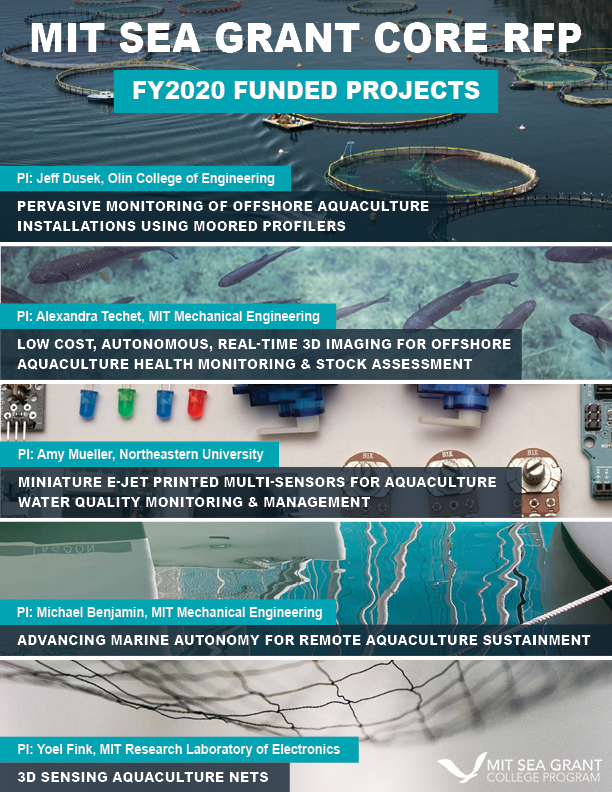MIT Sea Grant announces five newly funded projects propelling innovation in the aquaculture industry
MIT Sea Grant provides competitive funding opportunities for Massachusetts university-based research scientists who seek to address marine issues in ways that benefit the Commonwealth. The FY2020 call for proposals focused on innovations in offshore aquaculture and monitoring technologies.
Five research projects from MIT, Northeastern University, Olin College of Engineering, and Babson College have been selected for funding for the period of February 2020 through January 2022. Projects are funded up to $100,000 per year for a total of $200,000 for two-year projects.

Pervasive Monitoring of Offshore Aquaculture Installations using Moored Profilers
Jeff Dusek from Olin College of Engineering and Co-PIs Alessandra Ferzoco (Olin) and Joanna Carey (Babson College), will develop a low-cost moored automatic mobile profiler with modular sensor payloads for pervasive monitoring of aquaculture farms throughout the full life-cycle of installations, from site assessment to environmental impact analysis. Water quality monitoring with observations of fish growth rate, feeding patterns, and behavior will allow biologists and farm managers to identify key operational welfare indicators.
Moored profilers make repeated measurements of ocean currents and properties along the vertical water column; in this case, the profiler will be designed to leverage existing offshore farm infrastructure by traveling on “cables of convenience” to gather environmental and physical measurements. It will be tested in Massachusetts coastal waters in collaboration with industry and local farmers, and iterative design improvements will be made based on stakeholder feedback. More about this project >>
Low Cost, Autonomous, Real-Time 3D Imaging for Offshore Aquaculture Health Monitoring and Stock Assessment
Alexandra Techet from the MIT Department of Mechanical Engineering will design, fabricate and test an open source, low-cost, 3D light field imaging system for integration into offshore aquaculture systems. Using 4-6 camera elements and LED lighting, the system will have the capability of imaging in highly turbid environments, enabling remote monitoring and autonomous assessment of fish stock health, including individual and group behaviors, skin and fin health, stock populations, fish biomass, and fish-to-fish spacing within aquaculture pens.
Techet will perform bench testing with live fish schools in the laboratory before system water-proofing for field deployment, with design and environmental considerations informed by industry and academic aquaculture entities. Low-power autonomous imaging systems for monitoring fish stock health and growth can greatly enhance offshore fishery performance and reduce labor costs associated with visits to offshore farming sites, while mitigating fish stock disease or other loss. More about this project >>
Miniature E-Jet Printed Multi-Sensors for Aquaculture Water Quality Monitoring and Management
Amy Mueller and Co-PI Joseph Ayers, both from Northeastern University, will develop a game-changing solution for online monitoring of water chemistry for aquaculture applications by creating highly miniaturized low-power multisensor arrays using Electrohydrodynamic Jet (E-Jet) printing. Using a variety of metallic and biologically-based inks, the E-Jet printed sensors will be tested for detection limit, sensitivity, and selectivity, and packaged for biofouling protection.
Automation of water quality management and online sensing is required for enabling healthy closed-containment mariculture. This project aims to enable innovation in aquaculture by increasing available approaches for automated system management. The researchers will demonstrate this as an extensible platform by adapting existing sensor materials for use with E-Jet, and validating sensor functionality in controlled and open-water tests. More about this project >>
Advancing Marine Autonomy for Remote Aquaculture Sustainment
Michael Benjamin and Co-PI Michael Sacarny, both from MIT’s Department of Mechanical Engineering, will develop marine autonomy algorithms for unmanned surface vehicles to support aquaculture installations. Using remotely operated underwater vehicles deployed from unmanned surface vehicles, the team will provide operators with an ability to perform frequent, lower-cost remote visual inspection and water quality monitoring with minimal human effort.
Algorithms will be implemented on an existing MIT unmanned surface vehicle leveraging MIT open source software. The objective is to develop further algorithms made available to the general public to address safe navigation of a marine vehicle in support of aquafarming. After testing in a simulation environment and on the Charles River, the project will engage with stakeholders to support installation missions, with an initial focus on oyster farms.
Technology gaps in the aquaculture industry translate into high labor costs on tasks that are often dangerous and uneconomical. Tasks related to water quality sampling, monitoring sites, and inspecting equipment, offer opportunities for automation with unmanned marine vehicles to make aquaculture safer, more profitable, and scalable. More about this project >>
3D Sensing Aquaculture Nets
Yoel Fink from MIT’s Research Laboratory of Electronics will design and field test aquaculture nets with 3D-distributed depth profiling sensing capabilities to improve efficiency and yield of aquaculture operations. Fink will integrate environmentally-sealed fibers with embedded temperature-sensing microelectronics into marine ropes using industrial equipment. The sensing ropes will exhibit the ability to measure temperature — correlating to fish growth, health, and feeding behavior — at a defined spatial resolution in order to report ocean temperature as a function of depth at aquaculture sites.
The ropes will be tested in the laboratory and in the field to provide more comprehensive information and reduce the cost and logistical burden of aquaculture sensing. This will be a platform demonstration for other environmental sensing capabilities, including salinity, water turbidity, dissolved oxygen, pH, fish distribution, feeding needs and fish growth efficacy. More about this project >>
View all MIT Sea Grant projects on our Funded Projects page.



